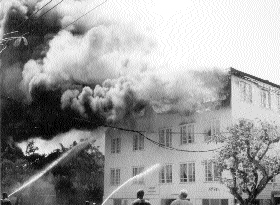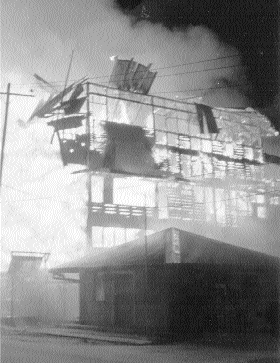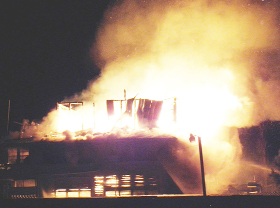Society
No other poor Caribbean country can equal Guyana’s extraordinary record of destruction of government buildings by arson. Notwithstanding the high cost, little has been done over the years to apprehend the culprits, to establish commissions of inquiry to investigate the causes or to initiate remedial action to prevent recurrences of the arson.
No one has had more to say about the mysterious fire that destroyed the Ministry of Health’s head office in Georgetown on Friday 17th July than the Minister himself. Within hours of the inferno, and even before the Guyana Fire Service and the Guyana Police Force had completed their investigations into the incident, Dr Leslie Ramsammy reached some definite conclusions.

He determined that the fire was “a clear case of domestic terrorism” and decided that there appeared to be “confirmation that people entered his ministry’s compound and firebombed the building.” Not only did he disclose that several other unexploded ‘channa bombs’ been found but, rather oddly, that the fire started in the top flat of the three-storeyed structure. It was his opinion, also, that broken glass windows in other buildings indicated that attempts were made to “totally destroy everything.”
The minister expressed his dissatisfaction with the security service on the premises. He said that he was the last person to leave the building a few hours before the fire and acknowledged that security at the ministry has always been a major problem for him, confessing, “I have never been satisfied in the 10 years at the ministry with the level of service provided by the contracted services…” He admitted too, that in the past, thieves had crawled under the fence of the compound and stolen vehicle parts but, only now, he squarely blamed Brans Security Service for the alleged breach of security and quickly replaced it with RK’s Security Service.

Even before the smoke cleared and the ashes cooled on the burnt-out site of the historic edifice, the minister was giving assurances that a new building will be constructed to “outclass” the building that was burnt down. He boasted, “We are determined that when we rebuild, it will be a Ministry that is going to take us into a different era in terms of health. We have already entered that era, with new and better services … and our Ministry of Health building will reflect that…” There is much that is deterministic about the minister’s declarations.
So far, there has been a lot of speculation but too little investigation. Despite the minister’s sweeping claims, uncertainty surrounds the actual causes of the fire. In fact, Head of the Presidential Secretariat Dr Roger Luncheon announced on 23rd July that the administration would accept assistance from the United States Southern Command to conduct investigations at the site. He reported soberly that the Cabinet had received a detailed report on recent arson on the Ministry of Health, the magnitude of losses and the historical and current records stored in the Ministry over the ages in print and electronic format that have been lost in the fire.

The fire at the Ministry was not the first strange destruction of a government building. It is therefore high time that, in addition to seeking assistance and receiving reports, the administration should establish a formal, impartial commission of inquiry to investigate the causes, to determine the circumstances surrounding the disaster and to calculate the cost of this fire. Unless it does so, action to prevent recurrences might not be taken.
Already, this administration has an unenviable record of actual arson and feigned attacks on government buildings. The first big fire was at the Ministry of Public Works and Communications accounts department which was destroyed during an audit there in February 1996. The Ministry of Finance was next; the records of the Central Tender Board were destroyed in another mysterious fire in June 1998. The Ministry of Education’s Finance and Personnel divisions were then gutted by fire in May 1999.
It was now the turn of the Ministry of Agriculture. The sprawling Mahaica-Mahaicony-Abary Agricultural Development Authority administrative centre at Onverwagt, WCB, was razed by fire in May 2001. The following month, June, the Ministry of Housing and Water was burnt down, destroying hundreds of transports, drawings, plans and other records. The Central Housing and Planning Authority, which was also housed in that building, was burnt out.
The Ministry of Local Government then joined the list of government ministries to which fires were being set. The Mahaica-Berbice Regional Democratic Council office at Fort Wellington, WCB, and the Demerara-Mahaica Regional Democratic Council office at Paradise, ECD, were burnt down in August and September 2006, respectively. The same month, soon after the general elections were completed, the Guyana Elections Commission lost important records in a fire in a major building in its compound in September 2006.
But arson by ‘channa bombing’ could also degenerate into sick humour. No one took the report seriously when, at the height of the protests against extra-judicial killings, the Ministry of Home Affairs claimed, in April 2004, that a ‘channa bomb’ was thrown at its main office in Brickdam. The ‘bomb’ merely smashed a couple of windows and scorched the walls of the conference room. The incident was quickly forgotten.
The Ministry of Culture, Youth and Sport was to make a similar claim when a boycott of CARIFESTA was threatened. Two channa bombs, which failed to explode, were tossed into the ministry’s Main Street, Georgetown, compound in May 2008. The next month, June, the Fire Service removed two improvised devices − consisting of four small cylinders which were later found to have contained propane but did not explode − from beneath the stage of the National Cultural Centre. For good measure, the Ministry of Public Works and Communications reported discovering a couple of channa bombs on its premises in Georgetown only on 19th July last. Again, neither the security forces nor the media made much of these so-called ‘attacks.’
Conjecture on the causes of these costly crimes can be misleading as there has often been no concrete evidence to substantiate the wild speculation even of high officials who should know better. No one has proven that these fires have been the work either of ‘domestic terrorists’ or of internal fraudsters who seek to destroy incriminating documents. Nor has the arson not been proven to be the work of political agents provocateurs who, during public protests, attack government and private premises in order to discredit legitimate protestors by creating the impression that the attacks were carried out by them.
The absence of evidence, however, has never prevented government officials from attempting to make political capital out of criminal incidents. The Government Information Agency reported, for example, in the case of the alleged attack on the Ministry of Home Affairs in 2004, “When asked if there was any evidence on which Cabinet has based its claims of an association between the PNCR’s behaviour and the arson attempt, Dr. Luncheon said “There is no need for definitive evidence to support an association…I highlighted the association and sought to highlight the fact that the association is nothing new.” With logic like this, it is difficult to understand who are the persons or what are the motives behind this criminal behaviour.
Official Fire Service reports of serious fires at government buildings over the last thirteen years are not laid in the National Assembly or published in the media. As a result, the public is exposed only to the administration’s self-serving rationalisations. What is worse than misinformation, however, is that despite the destruction of valuable governmental records and other public documents, no serious plan seems to have been put in place to protect other government buildings from fires or to prevent recurrences. So the fires continue.
Such arson should not have occurred at all and, certainly, should not have been so clearly concentrated in the properties of the central government. After all, the government itself possesses the main fire-prevention agency – the Guyana Fire Service – which investigates every fire to which it responds and sends its reports to the Minister of Home Affairs. He should take remedial action to curb this crime.
On previous occasions, albeit with respect to private dwelling places, Chief Fire Officer Lawrence David explained that the majority of house burnings were deliberate. According to him, investigations by the Fire Service suggest that some fires were usually set to destroy evidence of fraud, or were the result of property disputes, or were intended as revenge on other persons. The trouble was that such fires were worse than accidental ones because they are started with very flammable materials, spread quickly and razed small structures totally.
Given the notorious deficiencies of the Fire Service’s forensic resources in a country that celebrates its wooden architectural heritage, there is little wonder that arson is so commonplace and so effective. The Chief Fire Officer readily admitted that there have been occasions when investigators have come upon materials or substances which may have caused fires but they simply did not have the capability to test those materials and determine the causes of the conflagration.
In the case of the disaster at the Ministry of Health, the cause of the fire has not yet been announced although several bottles in pristine condition and containing channa, flammable fluid and wicks have been spectacularly discovered. Despite the certitude of the Minister’s assertions, it is still too soon to determine causation, much less motivation, for this act of arson. Some government fires occurred in suspicious circumstances and the Fire Service has been often stumped. If arson or sabotage is suspected, the cases are handed over to the Guyana Police Force which, of course, has limited laboratory facilities to analyse the materials associated with arson.
Within hours of the destruction of the Ministry of Health, President Bharrat Jagdeo announced that there would be a reward of $25M for information leading to the apprehension of those who might have been responsible for the arson. Given the government’s record of fires over the past 13 years, however, it is difficult to see the purpose of the president’s sudden generosity. What is needed is not a reward but a series of serious inquiries into all the cases in which public property has been destroyed by fire. The reward money could be better spent in acquiring the laboratory facilities and improving the Fire Service’s capability to investigate this type of crime.
President Jagdeo needs to remind his Cabinet of the principle of ministerial responsibility. When fire occurs, not by accident but after years of ignoring sloppy security and of self-confessed neglect, officials must be held responsible. Once ministers understand that they will be held accountable for disasters like these fires, they will start to pay more attention to fire safety.
Before the next government fire occurs, the administration should consider installing fire-fighting equipment − fire alarms, fire exits, fire extinguishers, smoke detectors − to in all government buildings most of which are still made of wood and tend to be in close proximity to other properties. Members of private security agencies which protect government buildings during the silent hours should also be trained in fire-fighting.
The Ministry of Home Affairs can do much more to protect government properties from fire by enforcing everyday safety measures. The Office of the President, in particular, can do much to curb the crime of arson by convening a public commission of inquiry into every major government fire and by insisting that ministers will be held responsible for the protection of the public property with which they have been entrusted.
Statements such as “There is no need for definitive evidence” contribute to lawlessness.
